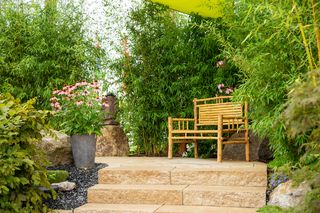How to kill bamboo and stop it causing damage to your home and garden
Bamboo is attractive to look at and hardy, but can quickly overwhelm an unprepared gardener.Here's our guide on how to keep it under control or kill it off entirely

Knowing how to kill bamboo can help protect your home from becoming overwhelmed when this plant grows out of control.
Bamboo is a popular choice ingarden designs because it grows quickly and is a natural and beautiful way of maintaining privacy and providing shade. However, left unchecked it can become invasive if not managed effectively. There is even the risk that it could cause structural damage to surrounding properties, fences, patios, and decking if left to spread.
Here we speak to the garden experts about how to kill bamboo when it becomes a threat.
How to kill bamboo — identifying bamboo type
Your first step in killing bamboo is to work out which type of bamboo you are dealing with as this can affect how is best to tackle getting rid of it.
Gardening expert Lee Smith atComposite WarehouseandUltra Deckingsays there are two different types of bamboo — clumping and running — and it is first important to assess which type you have growing in your garden.
“[Clumping bamboo] is less invasive and grows in tight groups, spreading slowly," he explains. "But running bamboo can quickly become a hazard as it grows and spreads much quicker. Phyllostachys is a particularly aggressive species that can be identified with long and straight shoots.”
Examples of clumping bamboo plants (clumped root system) include Fargesia varieties and Hibanobambusa Shiroshima, whichyou can see here,while running bamboo plants, which has long runner-type roots, includephyllostachys, Pleioblastus and Sasa varieties.
Lee Smith adds that it is imperative to complete any research prior to removing bamboo to make sure you use the correct techniques.
How to kill bamboo without using chemicals
Robert Silver, who runsthe Pro Gardening Blog, says a practical technique to control bamboo growth is to routinely prune bamboo stalks at ground level with pruning shears or a saw."
Pruning shears can be easily purchased from online retailers such as Amazon for as little as £7.20and asaw can be purchased for as little as £8.76.
“Removing the shoots interferes with the plant's capacity to absorb sunlight and develop. The plant gradually becomes less effective as a result of this steady loss of energy," he explained. “The trick is to be persistent and consistent. To efficiently deplete the bamboo's resources, regular cutting is required through the growing season, which is typically in spring and summer.”
Another technique is to regularly mow over the bamboo patch or dig a trench around the bamboo grove. Smaller bamboo patches in lawns or gardens can be mowed. By setting your lawnmower at a low height, you can cut emerging bamboo shoots and cutting off the underground rhizome network that permits bamboo to spread by digging a trench around it to create a physical barrier.
You can also use tough and flexible rolls, such as theYouGarden Bamboo Control Systemfrom Robert Dyas, to protect driveway edges, fences, patios from invasive spreading.
What will kill bamboo roots?
To kill bamboo, chemical herbicides likeglyphosatecan be a highly effective option, Lee says, especially when applied directly to the roots.
“There are also several natural remedies including vinegar and salt. However, while these can prevent bamboo growth, they won’t always provide a long-term solution,” he says.
“Another method for killing off bamboo is to deal with the roots, this will ensure a longer-term solution to prevent bamboo growth.
“You need to dig out as much of the roots as you can and continue to monitor the area, removing any new shoots that appear, this will weaken the bamboo until it dies. Spraying either natural or shop-bought repellents directly onto the roots and staying consistent in your efforts are also effective methods.”
What is the best weed killer for bamboo?
Robert says that given the potential effects on the ecosystem, using herbicides should only be a last resort. However, in situations where other methods prove ineffective or impractical, herbicides can be considered.
“Choose pesticides intended for controlling bamboo, typically containing active ingredients like glyphosate or imazapyr,” he says.
“When absorbed, these substances impede bamboo's ability to grow. To reduce environmental hazards, strictly adhere to product directions and safety precautions, put on safety gear, dilution or appropriate application rates, and refrain from overspraying. Be aware that herbicides may need to be applied more than once over the years to completely eradicate bamboo.”
Get the Homebuilding & Renovating Newsletter
Bring your dream home to life with expert advice, how-to guides and design inspiration, direct to your inbox.
Sam is based in Coventry and has been a news reporter for nearly 20 years. His work has featured in the Mirror, The Sun, MailOnline, the Independent, and news outlets throughout the world. As a copywriter, he has written for clients as diverse as Saint-Gobain, Michelin, Halfords Autocentre, Great British Heating, and Irwin Industrial Tools. During the pandemic, he converted a van into a mini-camper and is currently planning to convert his shed into an office and Star Wars shrine.
Most Popular
Bring your dream home to life with expert advice, how-to guides and design inspiration, direct to your inbox.
Thank you for signing up to Homebuilding. You will receive a verification email shortly.
There was a problem. Please refresh the page and try again.

